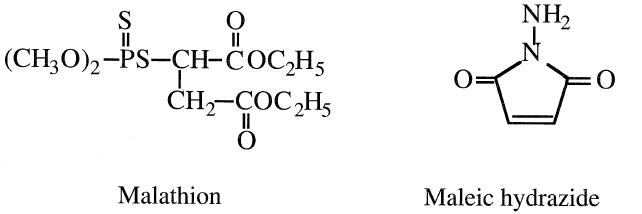


 علم الكيمياء
علم الكيمياء 
 الكيمياء التحليلية
الكيمياء التحليلية 
 الكيمياء الحياتية
الكيمياء الحياتية 
 الكيمياء العضوية
الكيمياء العضوية 
 الكيمياء الفيزيائية
الكيمياء الفيزيائية
 الكيمياء اللاعضوية
الكيمياء اللاعضوية 
 مواضيع اخرى في الكيمياء
مواضيع اخرى في الكيمياء
 الكيمياء الصناعية
الكيمياء الصناعية |
Read More
Date: 3-9-2017
Date: 11-9-2017
Date: 5-9-2017
|
Maleic anhydride
Maleic anhydride, a solid compound that melts at 53°C,is soluble in water, alcohol, and acetone, but insoluble in hydrocarbon solvents. The production of maleic anhydride from n-butenes is a catalyzed reaction occurring at approximately 400–440°C and 2–4 atmospheres. A special catalyst, constituted of an oxide mixture of molybdenum, vanadium, and phosphorous, may be used. Approximately 45% yield of maleic anhydride could be obtained from this route:

Other routes to maleic anhydride are the oxidation of n-butane, a major source for this compound and the oxidation of benzene.
Maleic anhydride is important as a chemical because it polymerizewith other monomers while retaining the double bond, as in unsaturated polyester resins. These resins, which represent the largest end use of maleic anhydride, are employed primarily in fiber-reinforced plastics for the construction, marine, and transportation industries. Maleic anhydride can also modify drying oils such as linseed and sunflower.
As an intermediate, maleic anhydride is used to produce malathion, an important insecticide, and maleic hydrazide, a plant growth regulator:

Maleic anhydride is also a precursor for 1,4-butanediol through an esterification route followed by hydrogenation. In this process, excess ethyl alcohol esterifies maleic anhydride to monoethyl maleate. In a second step, the monoester catalytically esterifies to the diester. Excess ethanol and water are then removed by distillation. The ethanol-water mixture is distilled to recover ethanol, which is recycled:

Hydrogenation of diethylmaleate in the vapor phase over a nonprecious metal catalyst produces diethyl succinate. Successive hydrogenation produces γ-butyrolactone, butanediol, and tetrahydrofuran.

Selectivity to the coproducts is high, but the ratios of the coproducts may be controlled with appropriate reactor operating conditions. Figure 1.1 is a block diagram for the butane diol process. 1,4-Butanediol from butadiene is discussed later in this chapter.

Figure 1.1. A block diagram for producing 1,4-butanediol from maleic anhydride.



|
|
|
|
التوتر والسرطان.. علماء يحذرون من "صلة خطيرة"
|
|
|
|
|
|
|
مرآة السيارة: مدى دقة عكسها للصورة الصحيحة
|
|
|
|
|
|
|
نحو شراكة وطنية متكاملة.. الأمين العام للعتبة الحسينية يبحث مع وكيل وزارة الخارجية آفاق التعاون المؤسسي
|
|
|